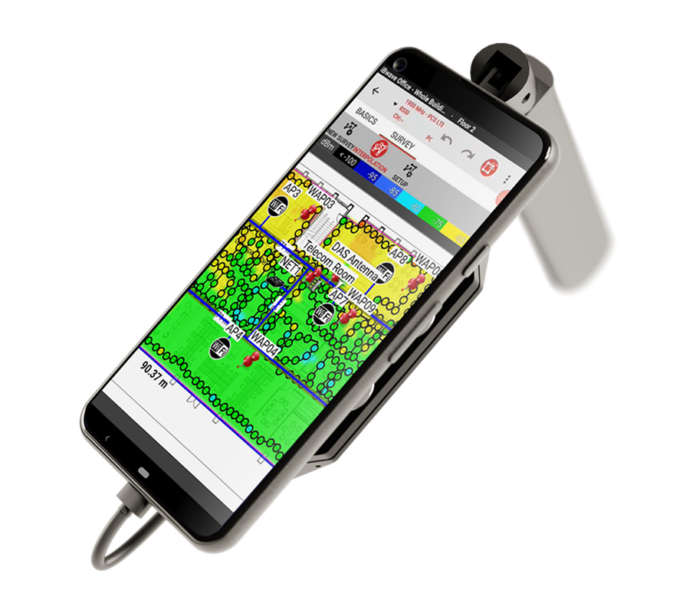iBwave, perhaps best known for its indoor network planning tools, is in the midst of widening its target market to focus on campus networks and public safety, as well as private networks, and move beyond the network planning market.
As part of those efforts, iBwave is launching a new mobile network survey tool today that supports public safety (specifically, P25 radio) and LTE networks and leverages a palm-sized RF scanner, developed by Epiq Technologies, which attaches to the backside of an Android smartphone.
“Existing scanner tools are often complex to use and heavy on the budget,” said Jamie Birdnow, senior VP of commercial operations at iBwave. “It’s also a challenge for our customers to share important survey data effectively with the design team because they are often using scanner tools not fully compatible with our design software. We want to provide a more seamless way for them to manage the entire survey and design lifecycle – which is why we’ve introduced a simple, affordable and seamless survey solution with our seamless integration
to the Epiq Solutions’ Prism scanner.”
iBwave, which was acquired by Corning in 2015, dominates the network planning space and began a more determined pursuit of the public safety market about two years ago, according to iBwave Director of Enterprise Solutions Basile Giese. Now, he says, the company plans to leverage its strong position in public safety network planning to pursue the network surveying market with the integrated Epiq scanner solution.
He points out that while there are public safety communication networks around the world, the market for testing such networks is driven by a given country’s regulations; U.S. requirements around in-building public safety coverage means that the bulk of the testing market is in the U.S. Building owners must certify to local authorities that they meet a jurisdiction’s specific rules around in-building P25 coverage metrics, and this means they have to have a network survey—which also has to be re-confirmed over time, usually annually.
Giese said that iBwave network planning files are often already used in that process, but usually with a third-party scanner that isn’t integrated with iBwave’s planning app and is a larger and more expensive piece of equipment that can pick up P25 signals (since smartphones don’t support those). The new solution not only adds a small scanner that has a range from 70 MHz to 6 GHz, it makes it easier to go back and forth between the network plan and the actual RF survey, staying within the iBwave user interface, to identify issues if coverage doesn’t match up to expectations.
The network surveying set-up uses an Android smartphone outfitted with an iBwave app, a small external antenna and Epiq’s Prism scanner attached to the phone back by a magnetic strip. It’s “very small, very light and very capable,” Giese says. The set-up allows users to take pictures, add notes or drop geolocated push-pins the surrounding environment for LTE cellular KPIs as well as get P25 signal information on band, channel, wide-area network (WACN), RF subsystem (RFSS), system ID, received signal strength and bit error rate. In addition, the unobtrusive size and fact that it uses a normal smartphone means that it is less likely to catch the attention of building users who might be alarmed by a walk-tester moving through a building with a heftier scanner set-up, Giese adds.
While the solution is launching with support for P25 and LTE, iBwave plans to expand that in short order. “We start with public safety, but it’s not going to be limited to public safety,” Giese said, going on to say that iBwave plans to add sub-6 GHz 5G support to the set-up in the coming months.
iBwave also hopes to disrupt the network surveying market on price-point with the new solution, Giese said. A large, traditional RF scanner for networks can cost $30,000 to $50,000, he says — and this one will cost less than $10,000. While it might not do signal acquisition fast enough to say, be used in highway drive tests, it suits the indoor building environment perfectly in terms of cost and capabilities, Giese added.
“The innovation that has the most chance to work is the one where you are going to save costs for your customers,” he said.

